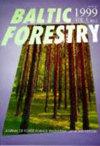The frequency method in studying habitat preferences of common forest birds
IF 0.6
4区 农林科学
Q3 FORESTRY
引用次数: 0
Abstract
This paper presents the results of a study on the habitat preferences of selected species of the bird community in the Morgi Forest, the Kolbuszowa Forest Division (SE Poland), with the use of the point-stand bird census method. The aim of the study was to test the effectiveness of the method in determining the frequency of colonisation of stands with different habitat parameters by the most abundant bird species. In 270 tree stands of a forest complex with diverse habitats, a bird census was carried out with four counts per each stand. Next, a list of the tree stands and the bird species recorded in the stands was compiled. The stands were divided into categories according to the forest habitat type, dominant species and age class. In the next step, the occurrence frequency of the most abundant bird species was calculated for each stand category. Among the analysed species, the majority showed a positive correlation between the frequency of occurrence and habitat fertility. The influence of the dominant stand species on the occurrence frequency of bird species was largely driven by habitat fertility. The lowest average frequency of the identified avian species was found in stands dominated by pine Pinus sylvestris, birch Betula sp. and black alder Alnus glutinosa. There was generally a positive relationship between age class and the bird community parameters. It is concluded that the point-stand method of bird census provides informative results for research on the habitat selectivity of bird populations.常见森林鸟类生境偏好的频率法研究
本文介绍了使用点站鸟类普查方法对科尔布佐瓦森林分部(波兰东南部)莫尔吉森林中选定鸟类群落物种的栖息地偏好进行的研究结果。该研究的目的是测试该方法在确定最丰富的鸟类在具有不同栖息地参数的林分中定居的频率方面的有效性。在一个栖息地多样的森林综合体的270个林分中,对每个林分进行了四次鸟类普查。接下来,编制了一份林分和林分中记录的鸟类名单。根据森林生境类型、优势种和年龄等级将林分划分为不同的类别。在下一步中,计算每个林分类别中最丰富鸟类的出现频率。在分析的物种中,大多数物种的发生频率与栖息地肥力呈正相关。优势林分物种对鸟类发生频率的影响很大程度上是由栖息地肥力驱动的。已鉴定的鸟类物种的平均频率最低的是以松、桦和黑杨为主的林分。年龄等级与鸟类群落参数之间普遍存在正相关关系。结果表明,鸟类普查的点位法为研究鸟类种群的栖息地选择性提供了有益的结果。
本文章由计算机程序翻译,如有差异,请以英文原文为准。
求助全文
约1分钟内获得全文
求助全文
来源期刊

Baltic Forestry
农林科学-林学
CiteScore
1.60
自引率
0.00%
发文量
23
审稿时长
>12 weeks
期刊介绍:
The journal welcomes the original articles as well as short reports, review papers on forestry and forest science throughout the Baltic Sea region and elsewhere in the area of boreal and temperate forests. The Baltic Sea region is rather unique through its intrinsic environment and distinguished geographical and social conditions. A temperate climate, transitional and continental, has influenced formation of the mixed coniferous and deciduous stands of high productivity and biological diversity. The forest science has been affected by the ideas from both the East and West.
In 1995, Forest Research Institutes and Universities from Estonia, Latvia and Lithuania
joined their efforts to publish BALTIC FORESTRY.
 求助内容:
求助内容: 应助结果提醒方式:
应助结果提醒方式:


